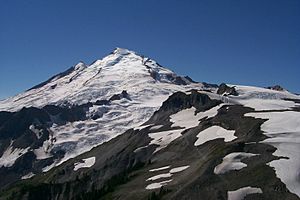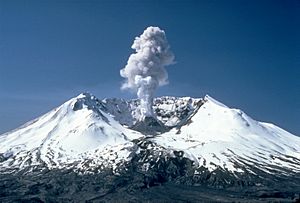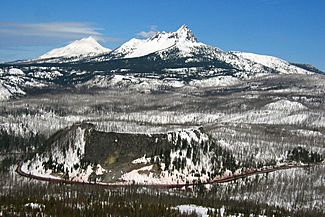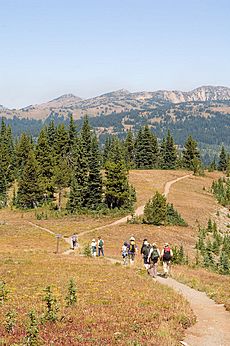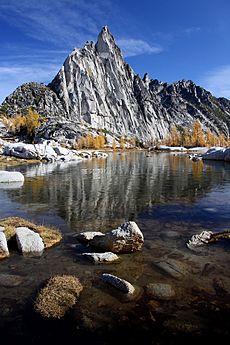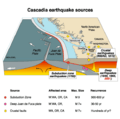List of Cascade Range topics facts for kids
The Cascade Range is a huge mountain chain in western North America, stretching from southern British Columbia in Canada through Washington and Oregon to northern California in the United States. It's famous for its many volcanoes, some of which are still active! This article will tell you about some of these amazing volcanoes and the special protected areas that help keep this beautiful region safe.
Contents
Amazing Cascade Volcanoes
The volcanoes in the Cascade Range are part of what's called the Cascade Volcanic Arc. This arc is a chain of volcanoes formed because of how the Earth's plates move. Here are some of the most important ones, listed from north to south:
North Cascades
- Coquihalla Mountain (in southern British Columbia, Canada) — This is the tallest peak in the Bedded Range. It's an old, well-preserved stratovolcano, which is a cone-shaped volcano built up by many layers of hardened lava, tephra, and ash. It's part of an extinct (no longer active) section of the Canadian Cascade Arc.
- Mount Baker (near the United States-Canada border) — This is the tallest mountain in northern Washington. It's an active volcano, meaning it could erupt again. You can often see steam coming out of its crater. Mount Baker is also one of the snowiest places on Earth! In 1999, a ski area on one of its smaller peaks recorded the most snowfall in a single season ever: 1140 inches (29 meters)!
- Glacier Peak (northern Washington) — This volcano is a bit hidden and hard to reach. Even though it's called "Glacier Peak," it doesn't have a huge amount of glaciers. It's surprisingly small in size and gets most of its height because it grew on top of a non-volcanic ridge.
High Cascades
- Mount Rainier (southeast of Tacoma, Washington) — This is the tallest mountain in the entire Cascade Range! It stands out and can be seen from far away. There isn't another taller mountain to the north until you reach the border of Yukon, Alaska, and British Columbia.
- Mount St. Helens (southern Washington) — This volcano famously erupted in 1980. The blast flattened forests to the north and sent ash all across the northwestern United States. The northern part of the mountain was destroyed in that huge eruption.
- Mount Adams (east of Mount St. Helens) — This is the second tallest mountain in Washington and the third tallest in the Cascade Range.
- Mount Hood (northern Oregon) — This is the tallest mountain in Oregon. Many people climb it, making it one of the most frequently climbed major peaks in the Cascades.
- Mount Jefferson (northcentral Oregon) — This is the second tallest mountain in Oregon.
- Three Fingered Jack (northcentral Oregon) — This is an old volcano from the Pleistocene era that has been heavily worn down by weather and time.
- Mount Washington (between Santiam and McKenzie passes) — This is a shield volcano that has been greatly eroded. Shield volcanoes are wide and gently sloped, like a warrior's shield.
- Three Sisters (near the city of Bend, Oregon) — These are three distinct peaks. South Sister is the tallest and youngest, with a clear crater. Middle Sister looks more like a pyramid and is more eroded. North Sister is the oldest and has a crumbling, rocky top.
- Broken Top (southeast of South Sister) — This is an extinct (no longer active) stratovolcano that has been heavily eroded. It still has the Bend and Crook glaciers on it.
- Newberry Volcano — This is a unique volcano with a large caldera (a basin-shaped depression formed after an eruption) that holds two crater lakes. The lava that erupted from here was very varied, and some flows even reached the city of Bend.
- Mount Bachelor (near Three Sisters) — This volcano is very young, less than 15,000 years old. It started as a shield volcano and became a stratovolcano. Today, it's a popular ski resort!
- Diamond Peak (south of Willamette Pass) — This volcano is 8,744 feet (2,665 meters) tall and is made of about 15 cubic kilometers of basaltic andesite rock.
- Mount Bailey (north of Mount Mazama)
- Mount Thielsen (east of Mount Bailey) — This volcano is highly eroded and has a very tall, pointed spire. Because of its shape, it's often called the "Lightning Rod of the Cascades."
- Mount Mazama (southern Oregon) — This volcano is famous for Crater Lake. About 6,900 years ago, a huge eruption caused most of the mountain's summit to collapse, forming a caldera. Before this blast, Mount Mazama was estimated to be about 11,000 feet (3,353 meters) tall.
- Mount Scott (southern Oregon) — This small stratovolcano is on the southeastern side of Crater Lake. At 8,929 feet (2,722 meters) tall, it's the highest peak in Crater Lake National Park.
- Mount McLoughlin (near Klamath Falls, Oregon) — This mountain looks perfectly symmetrical when you see it from Klamath Lake.
- Medicine Lake Volcano — This shield volcano in northern California is the largest volcano in the Cascades by its total volume.
- Mount Shasta (northern California) — This is the second tallest peak in the Cascades. It's so big that you can see it from the Sacramento Valley as far as 140 miles (225 kilometers) away! It's a very important landmark in the region.
- Lassen Peak (south of Mount Shasta) — This is the southernmost volcano in the Cascades and the easiest to climb. It erupted between 1914 and 1921. Like Mount Shasta, you can see it from the Sacramento Valley, up to 120 miles (193 kilometers) away. It's considered the lowest peak because the Cascades mountain range officially ends there.
Protecting the Cascades: Parks and Monuments
The Cascade Range is home to many special protected areas, including four U.S. National Parks, a National Scenic Area, and many National Monuments, Wilderness Areas, and National Forests. These areas help protect the amazing glaciers, volcanoes, hot springs, rivers, lakes, forests, and wildlife found here.
National Parks
- Lassen Volcanic National Park — This park was created in 1916 while its main volcano, Lassen Peak, was still erupting! It has some of the most active hot springs and steam vents in the United States, besides Yellowstone National Park.
- Crater Lake National Park — This park protects what's left of Mount Mazama, a huge volcano that collapsed thousands of years ago. The giant hole it left behind, called a caldera, later filled with rain and groundwater to become the beautiful Crater Lake.
- Mount Rainier National Park— This park surrounds Mount Rainier, the tallest volcano in the Cascades. Mount Rainier is covered by the largest system of glaciers in the United States outside of Alaska.
- North Cascades National Park— This park was created in a wild part of the range with very old rocks. The famous volcanoes Mount Baker and Glacier Peak are located nearby.
National Scenic Areas
- Columbia River Gorge National Scenic Area— This area protects the stunning Columbia River Gorge, a huge canyon carved by the Columbia River as it flows through the Cascade Mountains.
National Monuments
- Mount St. Helens National Volcanic Monument— This monument was created after the 1980 eruption of Mount St. Helens. It helps protect the devastated area and allows scientists to study how nature recovers after such a big event.
- Newberry National Volcanic Monument— This monument includes the area around Newberry Volcano in central Oregon, known for its unique volcanic features.
- Cascade–Siskiyou National Monument— This monument is in southern Oregon, right where the Cascade Range meets the Siskiyou Mountains. It's a special place where different ecosystems meet.
- Lava Beds National Monument— Located in California on the side of the Medicine Lake Volcano, this monument has the largest number of lava tubes (natural tunnels formed by flowing lava) in the United States.
Provincial Parks (in Canada)
- Skagit Valley Provincial Park
- E. C. Manning Provincial Park
- Cascade Recreation Area
- Cathedral Provincial Park and Protected Area
- Coquihalla Canyon Provincial Park
- Chilliwack Lake Provincial Park
- Coquihalla Summit Recreation Area
- Silver Lake Provincial Park
- Nicolum River Provincial Park
- Skihist Provincial Park
- Bridal Veil Falls Provincial Park
- Cultus Lake Provincial Park
Wilderness Areas
Wilderness areas are places kept as wild as possible, with very few human changes. They are managed by different National Forests:
- Wenatchee National Forest Wilderness Areas
- Alpine Lakes Wilderness
- Glacier Peak Wilderness
- Henry M. Jackson Wilderness
- Lake Chelan-Sawtooth Wilderness
- Norse Peak Wilderness
- William O. Douglas Wilderness
- Goat Rocks Wilderness
- Gifford Pinchot National Forest Wilderness Areas
- Goat Rocks Wilderness
- Tatoosh Wilderness
- Mount Adams Wilderness
- Indian Heaven Wilderness
- Trapper Creek Wilderness
- William O. Douglas Wilderness
- Mount Baker-Snoqualmie National Forest Wilderness Areas
- Alpine Lakes Wilderness
- Boulder River Wilderness
- Clearwater Wilderness
- Glacier Peak Wilderness
- Henry M. Jackson Wilderness
- Mount Baker Wilderness
- Noisy-Diobsud Wilderness
- Norse Peak Wilderness
- Wild Sky Wilderness
- Mount Hood National Forest Wilderness Areas
- Badger Creek Wilderness
- Bull of the Woods Wilderness
- Mark O. Hatfield Wilderness
- Mount Hood Wilderness
- Salmon–Huckleberry Wilderness
- Deschutes National Forest Wilderness Areas
- Diamond Peak Wilderness
- Mount Jefferson Wilderness
- Mount Thielsen Wilderness
- Mount Washington Wilderness
- Three Sisters Wilderness
- Willamette National Forest Wilderness Areas
- Opal Creek Wilderness
- Middle Santiam Wilderness
- Menagerie Wilderness
- Waldo Lake Wilderness
- Umpqua National Forest Wilderness Areas
- Boulder Creek Wilderness
- Rogue River – Siskiyou National Forest Wilderness Areas
- Sky Lakes Wilderness
- Rogue–Umpqua Divide Wilderness
- Fremont–Winema National Forests Wilderness Areas
- Mountain Lakes Wilderness
- Shasta-Trinity National Forest Wilderness Areas
- Mount Shasta Wilderness
- Lassen National Forest Wilderness Areas
- Caribou Wilderness
- Ishi Wilderness
- Thousand Lakes Wilderness
Images for kids


